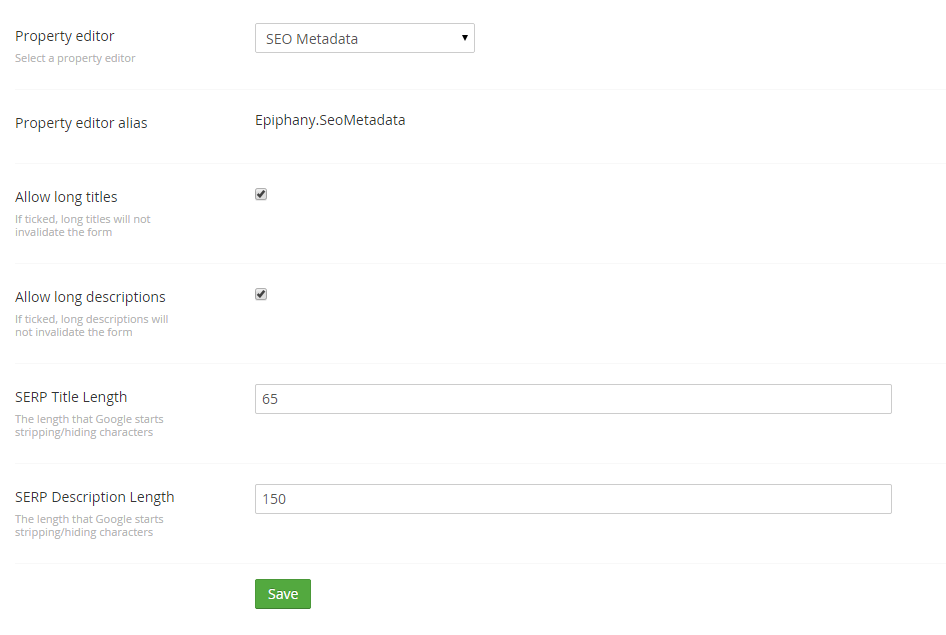This package is no longer maintained. See ryanlewis#35
SEO Metadata for Umbraco is a property editor that is used for maintaining common SEO-related information for a page. It gives users a visual representation of how the page would look on a Google search result page and hints to when the title and description is too long, with optional validation.
0.4.0
- Better handling when multiple domains are configured (#20, #23 - thanks @bjarnef!)
- Ability to configure an appended title to SEO titles (#22 - thanks @JJCLane!)
0.3.0
- Allow for recursive property values if all the fields are blank and the AppSettingKey is set.
0.2.1
- Fixed some issues with Umbraco package
- Resolved issue with PropertyEditorValueConverter returning null if page is saved when control is unused
0.2.0
- Fixed issue with custom URL Names not working if
SeoMetadata.NoSegmentProviderappSetting wasn't present - Added new option to set the developer name
0.1.0
- Initial release
Install the latest version through NuGet.
Install-Package Epiphany.SeoMetadata
After installing via Nuget, create a property editor of type SEO Metadata and include on your page. We recommend the property name "metadata" to work with all features out-of-the-box (see the URL Name section for configuration options)
Alternatively, if you want to hack around with the project, you can fork, checkout and develop locally. See the Developing SEO Metadata section.
- Allow long titles
- If ticked, long titles will not invalidate the property editor.
<dt>Allow long descriptions</dt>
<dd>If ticked, long descriptions will not invalidate the property editor.</dd>
<dt>SERP Title Length</dt>
<dd>The maximum length of a title. This isn't an exact number, so your mileage may vary. The default value of 65 is a conservative value that should work for most cases. Google will truncate overly long titles with ellipses (…)</dd>
<dt>SERP Description Length</dt>
<dd>The maximum length of the description. This isn't an exact number, so your mileage may vary. The default value of 150 is a conservative value that should work for most cases. Google will truncate overly long descriptions with ellipses (…) </dd>
<dt>Developer Name</dt>
<dd>Allows you to personalise the template a bit by putting the name of your company/agency/other. This is used within the descriptions on the view and is displayed to your content editors. </dd>
<dt>Site Title</dt>
<dd>Allows you to configure a site title that is appended to the title (e.g. " | My Company")</dd>
The SEO Metadata is stored as JSON, so can be used dynamically.
Title: @CurrentPage.Metadata.Title
Description: @CurrentPage.Metadata.Description
Do Not Index?: @CurrentPage.Metadata.NoIndex
URL Name: @CurrentPage.Metadata.UrlNameA Property Editor Value Converter is installed for getting a strongly-typed SeoMetadata instance.
@{
var metadata = Model.Content.GetPropertyValue<Epiphany.SeoMetadata.SeoMetadata>("metadata");
}
Title: @metadata.Title
Description: @metadata.Description
Do Not Index?: @metadata.NoIndex
URL Name: @metadata.UrlNameThe following snippet can be used for using the Do Not Index checkbox.
@if (Model.Content.GetPropertyValue<Epiphany.SeoMetadata.SeoMetadata>("metadata").NoIndex)
{
<meta name="robots" content="noindex">
}If you're a fan of ZpqrtBnk Umbraco Models Builder, you can add something like the following in your partial class
[ImplementPropertyType("metadata")]
public virtual SeoMetadata Metadata
{
get { return this.GetPropertyValue<SeoMetadata>("metadata"); }
}SEO Metadata also installs a UrlSegmentProvider to ensure the URL Name property works as intended. By default, it expects your SEO Metadata property to be called metadata. You can configure this property by adding the following setting to your appSettings in your web.config
<add key="SeoMetadata.PropertyName" value="seoMetadata" />If you want to disable the SeoMetadataUrlSegmentProvider altogether (to add manually, or implement yourself), you can set the following appSetting to disable it.
<add key="SeoMetadata.NoSegmentProvider" value="true" />You will find that recursive: true will not work as an instance of the SeoMetadata class will always return. You can override this behaviour so that
the resolver returns null. To do this, add the following appSetting key.
<add key="SeoMetadata.RecurseIfDefaults" value="true" />git clone https://github.com/ryanlewis/seo-metadata.git
cd seo-metadatanpm install -g grunt-cli
npm installbuild.cmd
gruntIf you wish to build it to a local Umbraco directory, use the target option.
grunt --target=c:\dev\path-to-umbraco-root-dir
